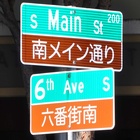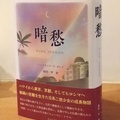Juliet Kono's novel "Darkness" depicts a Hawaii-born second-generation Japanese-American woman surviving a life of hardship during and after the war. Ippei Maeda, a scholar of American literature, translated the novel over the course of 10 years and published it at the end of last year. We asked him about the appeal of the novel and Japanese-American literature.
Hemingway and John Okada
--Mr. Maeda, you specialize in American literature, including the work of Hemingway, a classic of American literature, and you also study Japanese American literature. Why did you start researching literature in the first place?
Maeda: I got into literature when I was in high school. I was in the depths of adolescent angst about what I was living for, what was the reason for my existence, and without an answer I couldn't take a single step forward. So my university entrance exam studies were a disaster. So I turned to novels for answers.
Only when I was reading novels could I breathe. From Soseki to Dazai, Takeo Arishima to Naoya Shiga. There were people there who were struggling to find answers just like me, but there were no answers. However, I thought that if I went to the Faculty of Letters, I could search for answers without hiding. And that's how a local national university picked me up. In my third year of undergraduate studies, I read Hemingway's A Farewell to Arms in a class. I didn't find Hemingway appealing when I read the translation, but when I read it in the original I was struck by the weight of the suppressed emotions and the hopeless sense of emptiness. That's why I decided to become a researcher.
My interest in Japanese American literature was born during my graduate school days. I came across a novel called "No-No Boy" written by John Okada in a bookstore in Hiroshima, and was attracted by its unusual title, so I bought it. I started to read it, but stopped after about 50 pages because I didn't really understand it. I knew almost nothing about Japanese Americans. They didn't teach me about them in school either. So I thought that one day I had to do some proper research on Japanese Americans. That was the main reason I ended up studying under Professor Sumida at the University of Washington.
By this time, I was already over 50 years old. I became a member of the Asian American Literature Research Association in Japan, but I was not a latecomer to the society, but a middle-aged man. So, I was late to the party, and it seemed that I would end up not studying enough.
--How do you think Asian American literature and Japanese American literature are positioned within American literary studies in the United States and Japan?
Maeda: I don't know the details, but as I mentioned earlier, I think that Asian studies and education are developing in the United States, especially at universities and research groups on the West Coast, centered around UCLA and Berkeley. In Japan, the Society for the Study of Asian American Literature (now the Society) was started in 1989, and now has a large number of members and is actively engaged in academic activities and publishing.
Japanese American Literature Societies and American Studies Associations have begun to include research presentations on Japanese American literature on an annual basis. However, there are very few universities where Japanese American literature is researched and taught, even in the English department, unless there is a specialized faculty member. I would like to see the Asian American Literature Society further develop research and education in Asian American literature, including Japanese American literature. However, isn't the foundation of literature the existence of a general readership? To that end, I would like to steadily continue translation work, alongside, or even before, my research, to deliver excellent Japanese American literature to the general Japanese readership.
--You previously translated Jamie Ford's best-selling book, "Hotel on the Corner of Bitter and Sweet," which has a Japanese-American protagonist during the war. The author is not of Japanese descent, so what do you think is the difference between this book and works by Japanese-American authors like the one you translated this time?
Maeda: Jamie Ford has a white name, but he is of Chinese descent. That's why he writes novels with Chinese-American characters as the central characters. However, "At the Panama Hotel" is told from the perspective of a Chinese boy gazing at a Japanese-American heroine, so when Japanese people read it, it feels like the Japanese are the central characters.
Novels written by non-Japanese authors about Japanese people that have been translated into Japanese include the aforementioned Jay Rubin's "Days of the Sun" and David Guterson's "Murder Suspect." Both are works by white writers from Seattle. Rubin is a researcher and translator of Japanese literature. Guterson majored in English literature at university and seems to have become a writer after working as a high school English teacher.
The original title of "Murder Suspect" is "Snow Falling on Cedars," and it can be said to be serious "pure literature" dealing with racial issues, but as you can tell from the Japanese title, it was published as a mystery in Japan. It was also made into a movie. There is also "Portrait of a Japanese American" by Nina Lovoir. Lovoir's father is Polish-American and her mother is Japanese, and she lived in Japan until she was five years old.
I think that novels that depict the racial diversity of Los Angeles while having Japanese-Americans as the main characters also express their own racial hybridity (I'm not sure if that's the right word). In this way, we need to pay attention to the racial diversity of writers who portray Japanese-Americans. In that case, we need to make sure that there are no prejudices or preconceptions in the way they portray the physical characteristics and culture of Japanese-Americans. I don't think Jamie Ford had that.
--Memories of the war are gradually becoming distant even within the Japanese community. Do you think Japanese-themed literature will change in the future?
Maeda: If authors become more diverse, Japanese American literature will also become more diverse. Julie Otsuka, whose father is Issei and mother is Nisei, was born after the war in 1962, and in her books When the Emperor Was God and The Buddha in the Attic, she has carefully researched Issei picture brides and internment to create stories. However, internment and picture brides, which were important themes in Japanese American literature, may now become classic subjects that require further research.
"Buddha in the Attic" tells the story of Issei women's lives in America and the conditions of internment, starting from their journey as picture brides, but for those who have studied basic Japanese-Americans, it may seem like a boring repetitive story. That's how I felt. From now on, we will be in the era of the Yonsei and Gosei, so the experiences and consciousness of Japanese-Americans that are different from the discourse of the Issei and Nisei internment may become the subject of novels. I'm looking forward to it, as I don't know what will happen.
--What do you think is the appeal of Japanese American literature?
Maeda: My greatest interest in Japanese American literature is the strong desire that American-born second-generation Japanese people have to assimilate into white-dominated society, as seen in Ichiro in "No-No Boy" and Kazuko in "Nisei no Musume."
As a Japanese person born after the war, I was fascinated by the looks and physical characteristics of white people I saw in Hollywood movies: blonde hair, tall stature, deep-set features, and the English language. However, the desire of second-generation Americans to assimilate into white society is fundamentally different from such longings. Kazuko in "Nisei no Musume" is able to leave the internment camp because she finds a school that will accept her. From that school, she returns home for Christmas vacation to the former internment camp where her parents are. When the vacation is over and she is returning to white society by bus from the camp, she says that her parents, seen from the bus window, looked like "greedy immigrants."
Some American researchers criticize this tendency toward assimilation. I think it's a difficult issue, especially for me, who is not directly involved. I'm also looking forward to the translation of "Nisei no Musume (Second Generation Daughter)."
(end)
© 2024 Ryusuke Kawai







